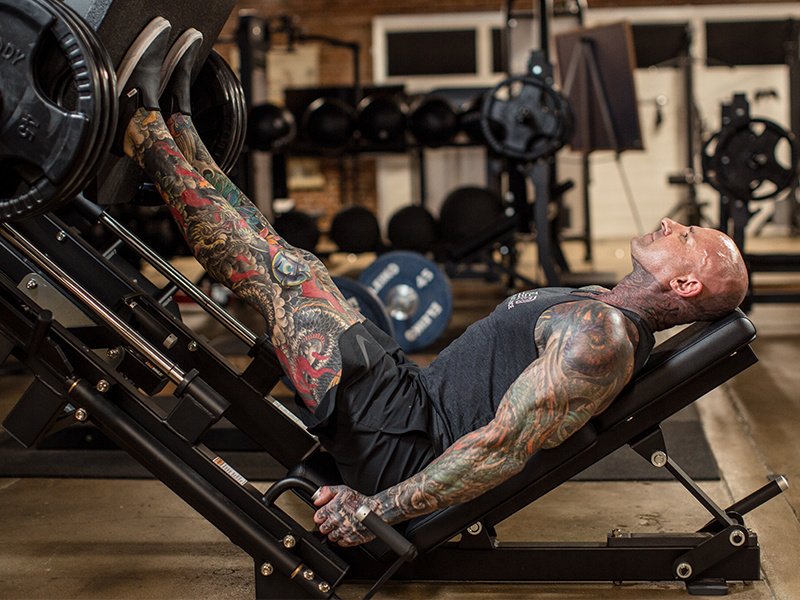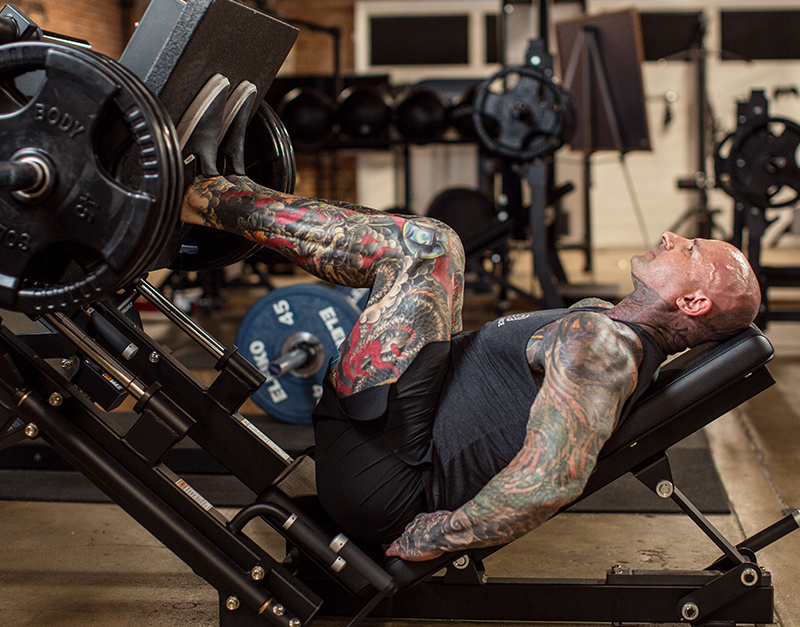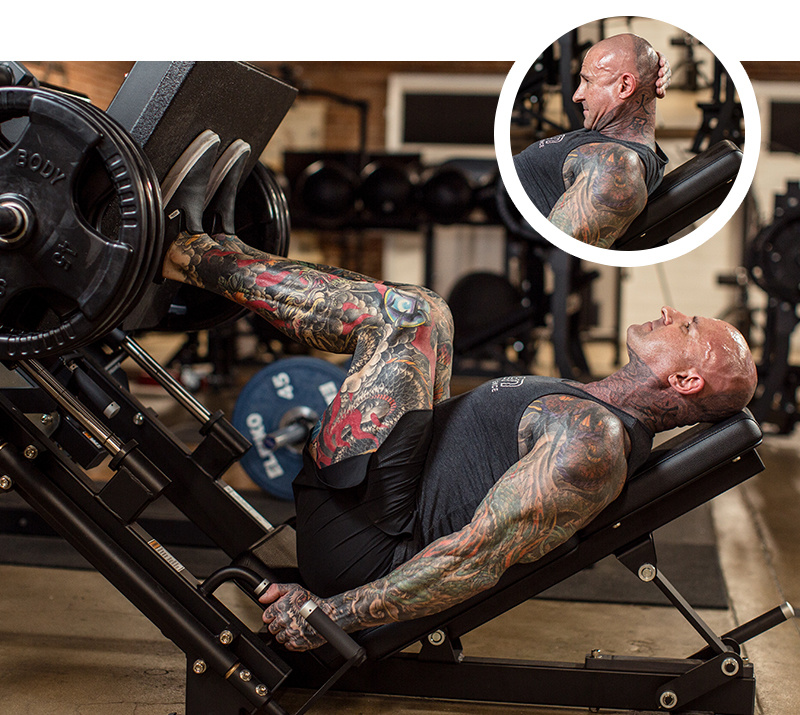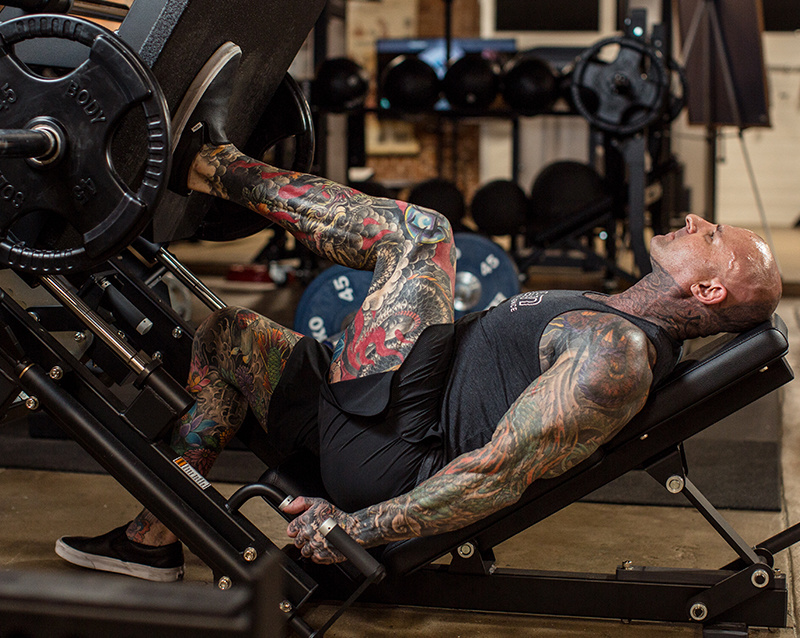Leg Press Master Class
Target your quads with both variations (two-legged and one-legged) of this common lower body exercise.

Target your quads with both variations (two-legged and one-legged) of this common lower body exercise.

Note: The above video was recorded as a Facebook Live tutorial in conjunction with the Train With Jim Full-Body Shortcut to Size program.
There are a variety of different leg press machines in gyms, but when we talk in bodybuilding and weightlifting terms about the leg press, we're really talking about the 45-degree leg press, or the “sled,” as it's sometimes called.
The leg press is often used as a foundational lower body exercise in people's training programs. But should it be? Generally speaking, probably not, but it depends on your individual goals as well as any physical limitations or injuries you may have. I’m not saying the leg press is a bad exercise, but I'm going to tell you in this article why it's not the best leg exercise for overall development.
Yet, I'm also going to tell you the main benefits of this movement (specifically related to quadriceps development), so if those align with your goals, then the leg press absolutely has a place in your program.
Let's start by discussing the anatomy of the exercise...
The muscular anatomy is critical to the biomechanics that we're using on the leg press. When you're doing the leg press, the problem, frankly, is the ass – your hips. Look what happens when I sit in the leg press: No matter how I adjust the seat, it still limits hip extension.

When I do the leg press, see if you can tell the difference between it and a squat. I lower down to about 90 degrees at the knees in the bottom position, then push back up. At the top, it’s just like a squat, right? WRONG! On a squat, am I bent forward at the top, with my legs and torso at 90 degrees like with the press? No! My body is straight, fully upright. My point is, the leg press limits the extension at the hips. It's basically like doing a squat with no hip extension, bent over at the waist at the top of the rep. You would never do a squat like that!
What muscles are involved in hip extension? Your glutes and hamstrings. In the above video, I point out these muscles on the anatomical model of the leg (at around the 3:30 point). You’ve got the gluteus maximus as well as the three hamstring muscles (long head of the biceps femoris, semitendinosus, and semimembranosus). The biceps femoris has two heads – a long head and a short head – and only the long head crosses the hip joint. Just like with the biceps brachii on the arm, which has a long and a short head, and only the long head crosses the shoulder joint. Same concept here.
Bottom line: When you're doing a leg press, you’re not getting much use of the hamstrings or the glutes because of the lack of hip extension. So, if this is your main leg exercise and you’re wondering why you have no ass, or your hamstrings are weak, it's because you’re focusing on the leg press.
What you're really maximizing on the leg press is the use of the quads. So let’s break down that large muscle group…
As the name implies, there are four muscles that make up the quadriceps: rectus femoris, vastus medialis, vastus lateralis, and vastus intermedius. All four converge down into the same tendon (the quadriceps tendon), which crosses the knee joint.
The rectus femoris is the big one up top that gives you that sort of “sweep” on the front of the thigh, and it’s the only quad muscle that crosses the hip joint (the others attach on the femur). That’s why it’s involved in hip flexion.
Just underneath the rectus femoris is the vastus intermedius; then, we have the vastus lateralis, the outer quad muscle that provides the outer sweep to the thigh; and finally, the vastus medialis, which is the “teardrop” muscle on the inner part of the knee.
The primary function of the quads is knee extension (aside from hip flexion from the rectus femoris), and that’s really the main movement with the leg press. As I said before, there’s very little hip extension here, so don't use the leg press as a hamstring and glute exercise. It’s mainly a knee extension exercise, focusing the tension on the quadriceps.
One thing you hear all the time is this: “Put your feet high up on the leg press platform, versus lower down, to hit more of the hamstrings.” To some degree, yes. The lower you go on the leg press platform with your feet, the more quadricep involvement and even less hamstring involvement. But again, even at the highest foot position on the leg press platform, you still don't have that hip extension you get when standing up doing a squat or deadlift.
With the leg press, you’re mainly using the vastus medialis of the quads, that “teardrop” muscle I mentioned earlier. In fact, one study out of Japan found that the narrower your feet are on the platform, the more the vastus medialis is worked. We used to think a wider stance would hit more of the inner quad, but that doesn’t seem to be the case.
So, if you're trying to build big outer quad sweeps, this is probably not the best exercise for you. But if you want to bring up that teardrop area, here's your tool right here, the leg press.
That’s what bodybuilding is all about – knowing which tools to use to get the job done. Just like when a plumber walks into a job, right? If the toilet’s clogged, he needs a snake. He's not going to use the snake if it’s a leak; he's going to use a different tool.
So, if there's a trainer that tells you to never use a piece of equipment, it just means he or she doesn't know how to use the tool. That would be like a plumber telling you to never use a plunger because most of the clogs he deals with require a snake. If a trainer tells you to never use the leg press, he doesn’t how and when to use that piece of equipment. He just shuns it because he doesn't understand it.
A lot of people say not to do the leg press because its poor for the hamstrings. Yeah, but it's great for the quadriceps. So, people who specifically want to build up their quads, whether it’s to take care of a muscle imbalance or you’re a bodybuilder who wants a more developed teardrop, the leg press is a great exercise.
Know the tool and when to use it. Like I said, don't make the leg press your primary leg exercise unless you're doing it for a reason. Maybe it reduces the stress on your lower back and allows you to finally train legs. That's better than nothing!
To reduce injury risk when doing the leg press, there are two key body parts you want to be conscious of at all times: your butt and your head.
The most critical thing that you want to be conscious of when doing the leg press is your butt in the seat. Where is your butt as you’re coming down? This is where people get lower back injuries.
A lot of people say, “I do the leg press because it reduces the stress on my lower back.” This is true if you’re supported in the leg press machine and you’re stopping before your butt starts coming out of the seat. However, if at the bottom of the movement your butt is coming off the bench, that’s going to eventually cause a back injury or at the very least hurt like hell. What's happening here is I'm causing spinal flexion as I come up with all that weight.
Here’s a photo of me doing the leg press the WRONG way. Notice how my butt is off the seat at the bottom, to where I’m to put my hand in the space between my butt and the pad:

Make sure you come down to where your upper legs and lower legs are at 90 degrees, but your butt isn't coming up off of the seat.
Head position is critical on the leg press. Do NOT have your neck flexed forward, where your head is off the pad, during the lift. You see people doing this all the time in the gym and even in photos where so-called “experts” are demonstrating the exercise. Good luck with your cervical and thoracic spine moving forward if that's the way you do your leg presses. Please don’t do it that way! It will definitely cause a neck issue.
Make sure the back of your head stays in contact with the pad throughout the set, like this:

On the concentric (positive) portion of the rep, I push through my heels to reduce the stress on the knees. However, if you want to hit more quadriceps, you can push with the balls of your feet, similar to a sissy squat.
However, if you have knee issues, I strongly suggest pushing through the heels. This also makes for a much stronger leg press. It's the same concept when you're doing a deadlift; you’re driving up through the heels.
I’ve covered the standard, two-legged leg press pretty thoroughly to this point. Now, let's talk about the one-legged version.
The main reason I like the one-legged version is because, as I mentioned before, letting the butt come out of the seat and the head come forward are common issues on the leg press. This is often the result of people overloading the machine with heavy weight and struggling to bang out reps. I want to prevent this, and I find the one-legged leg press to be a slightly safer variation than two legs.
What happens is, with the non-working leg down, I sort of have my butt anchored into the seat. So as I come to the bottom of the rep, it’s less likely that the weight is going to cause me to pick my butt up off the seat.

Another reason I like the one-legged version is because it helps address imbalances. A lot of people have strength and size imbalances in the legs, where there’s a “dominant” and a “weak” leg. Using the one-legged version is a great way to focus on each leg individually and minimize this issue.
Technique-wise, the one-legged version isn’t much different than two-legged. You want to push through the heel, keep your head back on the seat, bring the weight down so that the leg is at 90 degrees and your butt is not coming out of the seat.
With one-legged leg presses, you’ll do all reps on one side before switching to the other leg.
Find this exercise on Day 5 (legs and calves focus workout) of all four weeks of my Full-Body Shortcut to Size program.
Related Articles